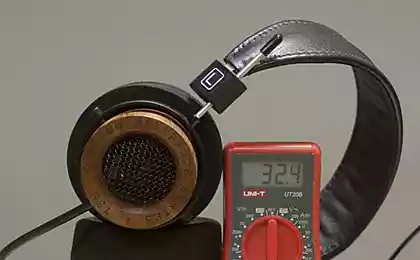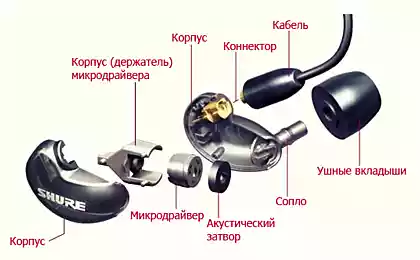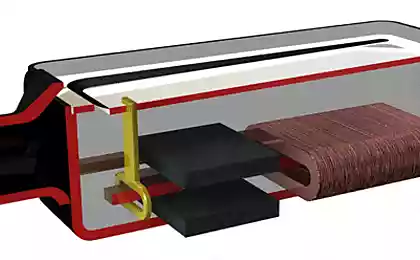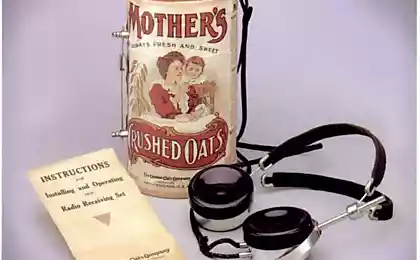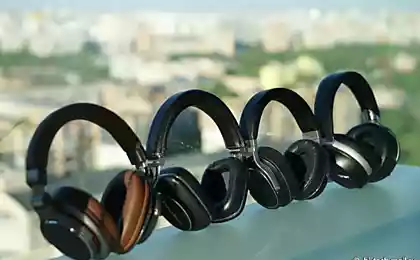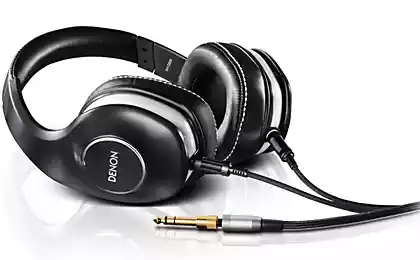1814
Secrets of the technical characteristics of the headphones
Opening its presence in GeekTimes we decided to start with something technical. And what better than to hold a conversation with a well-known expert in the field of technical measurements by setting a variety of tricky questions?
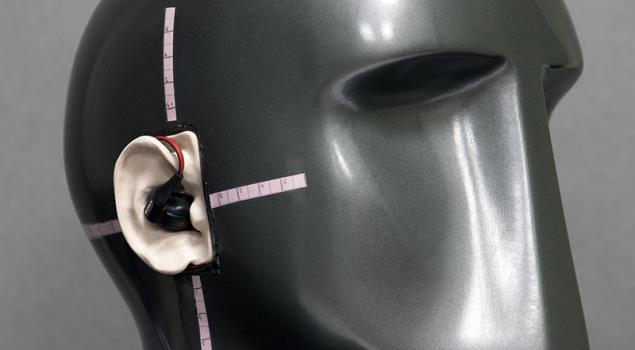
We asked a lot of questions to the founder of the project Reference Audio Analyzer in Russia Roman Kuznetsov, known under the pseudonym romanrex, the author of numerous articles, a long-time measurements audio equipment.
Some of the questions we asked earlier clients, in consultation and we have included them accordingly in an interview.
Alex: What features are most important in the headphones? I>
Roman: Of those that are usually specified on the box, only the resistance of the headphones (impedance). This is the only feature, which you can navigate.
Alex: And what frequency range? I>
Roman: For measurements headphones there is no single "correct" stand. Today, there are many different manufacturers of headphones stands for different tasks. This also applies to different methods of measurement of characteristics from the stands.
Different stands give different response (amplitude-frequency characteristics). According to one method of the range must be defined:
On the first - the decay of 1 dB, In the second - 60 dB, On the third - that would be the failure was not more than 30 dB per octave.
No stand, no technique, no standard box is usually not indicated and numbers in the form of 20 Hz-20 kHz can mean anything. Quite often you can see a wide range or a very expensive high-end models, or a cheap low-quality headphones for 100 rubles.

The difference frequency response of the position of the microphone on the stand
Unfortunately, even within the range of headphone manufacturers are measured at different stands with different methods and the results are not comparable between the headphones. Typically, the figures fall to the packaging are what need marketer. All specifications are optional and not controlled by anyone. Some manufacturers do not result in any performance (Beats Audio, Bose), while others print them just because their competitors.
Alex: Then characteristics completely useless?
Novel: Features can be compared with each other only within the same measurement conditions with one stand. Today, the Internet, there are several large databases measurements headphones where you can compare the characteristics of some headphones with others. Knowing what the stand and used as measurements were conducted, one can estimate the difference between the headphones.
Alex: And what stands most correct? I>
Roman: There are no 100% correct stand. There are both universal and specialized for high precision measurement of certain characteristics. For example, there was a situation where I had to check the difference between left and right channels in headphones with big soft ear cushions (Audez'e LCD-2). Headphone ear pads have always affect the land and worsen outcome, although subjectively these differences eliminates ear.
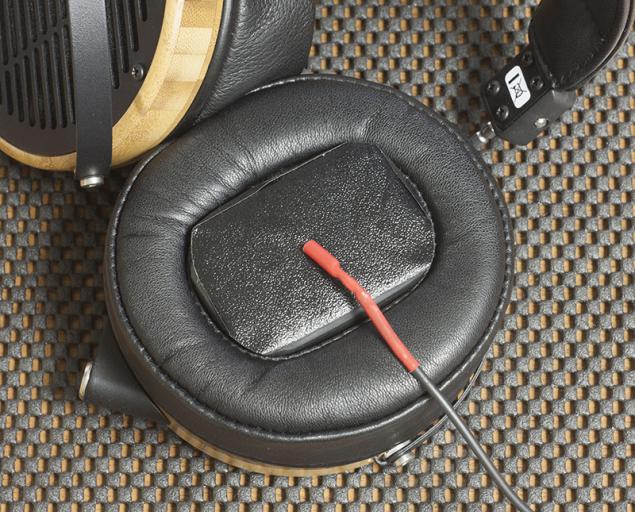
Special stand to measure the difference in response between the right and left channel headphone Audeze
We can not be removed Audeze ear pads - they are glued. For what would be the right and left channel of the headphones was in the same conditions for the measurements had to make a separate bridle. Line frequency response at this stand far from the perceived person, but just shows the difference between the channels. In a particular case, the difference in response was negligible.
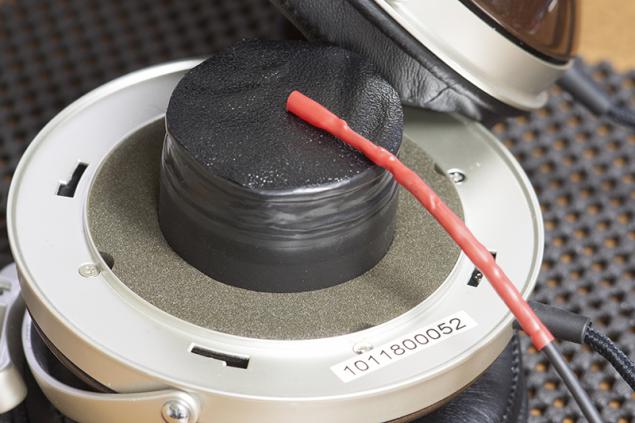
Special stand to measure the difference in response between the right and left channel headphones Denon D7000
But it is not only necessary to measure Audeze without embouchure, this rule applies to almost all headphones, ear cushions removed and measurements are made through a special camera with a microphone.
For measuring the frequency response close to the perceived subjective needs stand most similar to a human head. However, in the academic world there is no agreement, where the microphone should be positioned, broken a lot of copies, and the answer is no. Theoretically, the microphone located at the tympanic membrane is required to give a correct result, with resonance in the region of 2-5 kHz due to the ear canal. Stand with the location of the microphone at the entrance to the ear canal does not give resonance and theoretically less correct. Students also indicate that the response received from the stand with a microphone in the ear canal closer to what they hear, but do not hit 100%. This is not surprising, because each is unique to your ear.
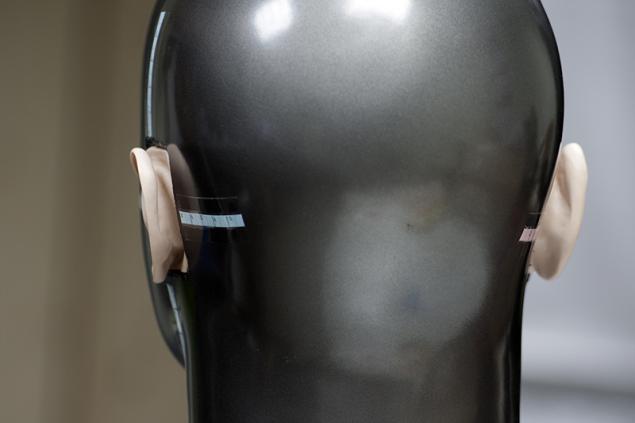
Now the project Reference Audio Analyzer stands ready to a new generation, which achieved high precision acoustic damping. To configure a new stand headphones measured on living human head, with fixed microphones. A new stand fully coincide with the "live" results.
Had the opportunity to compare the results of the test headphones from standardized artificial ear from Brüel & Kjær. In standardized stand used inner tubes for creating an acoustic damping equivalent living ear. The result in this case was not as close to a living ear, rather than the new stand RAA.
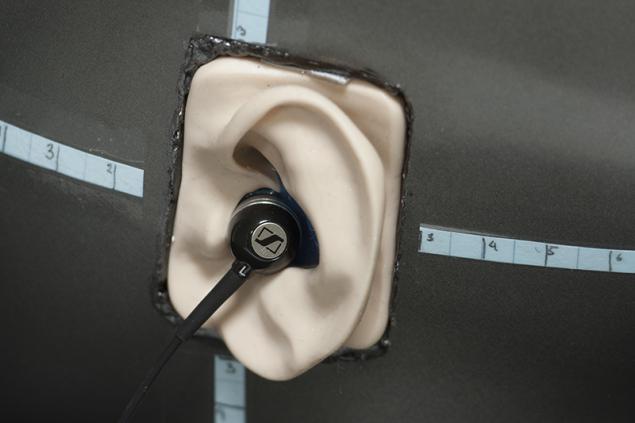
Anatomical accuracy of ears of a soft material
We stand with auricles inevitably suffers response parameter difference between the right and left channel.
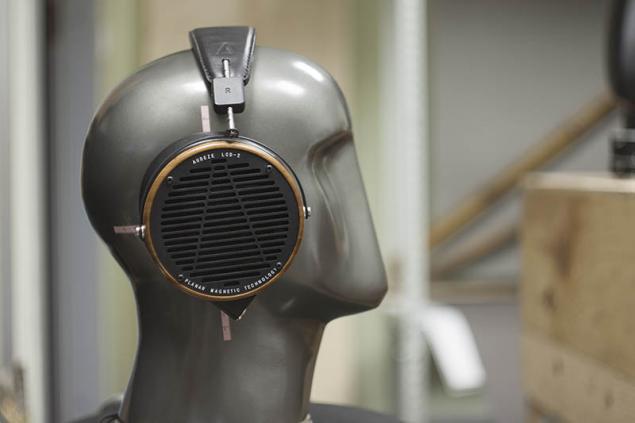
Stand new generation RAA HDM-X
Alex: Well, what characteristics are sufficient to determine the quality? I>
Roman: Unfortunately we can only measure some parameters. There are various methods for determining the quality of, for example, there is a good test FSQ, which is designed acoustic centers of the Department of Broadcasting and electro Moscow Technical University of Communications and Informatics (È). Subjective assessment is of the order of 14 basic parameters, where the AFC AFC directly or indirectly covers 3-4 parameter. A number of other parameters can be measured, but no coherent psychoacoustic model. Some parameters can be measured, but with a greater risk of damage to the headphones (eg overload capability), and some parameters require too time-consuming tests, time consuming and difficult to process. For this reason, the characteristics complement or give to make an informed choice under specific operating conditions headphones.
Another important priority allocation between the characteristics. It was once thought that the flat frequency response - a guarantee of quality. Later it became clear that this is a misconception, because in pursuit of a flat frequency response in the other parameters were sacrificed.
All specifications - this auxiliary data to assessing who should be treated with caution.
Alex: But the more options, the more we can say about how sound headphones? I>
Roman: Of course, although there is often confusion and substitution of concepts. After all, we can measure not only that directly related to the subjective perception, but also the fact that the sound of a direct relationship has not. For example, since the impulse response is determined by the phasing and the presence / absence of high-frequency resonance. But a number of militant audiophiles try to see on the pulse "speed" and "attack" that applies only to amplifiers with a flat frequency response, and does not apply to the headphones with non-uniform frequency response. Despite the name "speed", it does not replace the definition of attacks from psychoacoustics. This is as a characteristic for the car, where the motor is located in front or behind. And audiophile approach is better "fast" cars are racing a Formula 1 car on a par with "Zaporozhets" and at worst "Lada", "Mercedes" and "Bentley".
Alex: If little which parameters can be measured, what is it worth doing it? I>
Roman: That part of the parameters that can be measured can significantly help in the final product selection. According to the AFC, we can make a choice between "more" bass or "light" headphones, which is sufficient for the comparative analysis listen to one of the models. Sensitivity of headphones can predict whether there is enough power in the amplifier for specific player headphones.
Alex: That is, do not expect a simple rating system for quality? i>
Novel: The only correct and suitable for all, without exception, the rating system can not exist. But there is a fresh operating time rating, which, based on technical measurement data can predict a number of recommendations for the conditions OPERATE. There will be something like "rating with stars" for Headset for different purposes. The model is based on statistical models of headphones 500 and 100, respectively, and the amplifier has a sufficiently high accuracy.
Alex: And what is necessary for that to begin measuring headphones, what equipment? I>
Novel: standard equipment for measuring headphones rather expensive and unless you are lighten up, you can start with an inexpensive microphones and flat design of the stand. Most of the problems at an early stage is not connected with the equipment and software, and expertise where it is important to distinguish the test was completed correctly or not. Of the software can recommend RMAA and ARTA.
Once acquired experience can be determined to go forward in the development of stands or not. In the manufacture of equipment is strictly divided into "parting" and "indicators". Devices are subject to certain standard (our guest) and the results are valid. Indicators may be several classes higher accuracy in comparison with the devices, but does not have a legal validity. Adding Equipment Standard - expensive pleasure and short runs can be observed cosmic prices. In order to fix the result when modding headphones, the race for standardized equipment looks unreasonably expensive.

Bechringer ECM8000 microphone capsule and Panasonic WM62
Of the microphones can start with the popular Behriger ECM8000 and virtually any sound card with support for phantom power and ASIO. Later you can buy or immediately microphone capsules, for example Panasoinc WM62, each of which stands at $ 1-2 and take measurements from them, calibrating or checking their performance through ECM8000.
The design of the flat bench is very simple, and the Internet often can be found results similar headphones and therefore figure out how to get valid measurements. But some discrepancies still be, as corny all use different amplifiers and matching amplifier's output impedance and the impedance of the headphone frequency response change. In such RAA this effect is compensated and the result corresponds to the measurement of the "ideal" amplifier with zero resistance. None of the software today such compensation can not do it.
Alex: Are there any books or other materials on measurements? I>
Roman: Unfortunately, no, as no short instructions. Sometimes the questions come in the style of "I have a E-MU1616m, downloaded RMAA, how do I measure the quality of ...". On the question of what difficulties: in RMAA or adjusting E-MU1616m, come great answers: "Yes, I still do not run RMAA - heard only that she can measure something, tell me what and how ...". Here we can only say one thing, if there is no real desire for self-development, then forget about measurements immediately. Enough good equipment, suitable for measurements have many, but measure units, as everything here is an experience. It's like pick up a scalpel and naive to believe that became a surgeon and is fully prepared to carry out this operation. Development requires a gradual practice. Should be done step by step. Individual answers to different questions have long been in the network.
Alex: In recent years, were there any breakthroughs in the field of measurement of headphones? I>
Roman: Radically new tests over the past decade does not appear, but before headphones outside production virtually none was measured. Today it is done by some media, plus there are separate base measurements headphones.
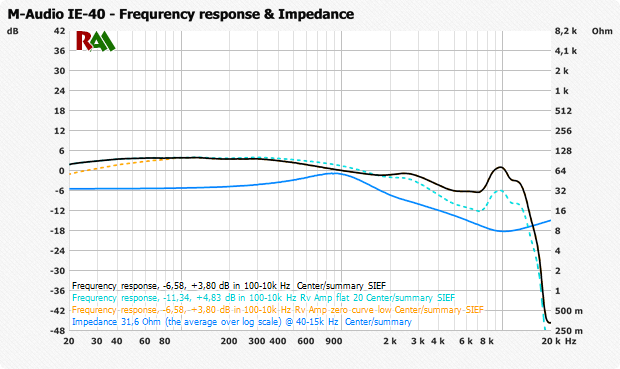
A striking example of how the AFC M-Audio IE-40 (UltimateEars TripleFi 10) with an amplifier like Colorfly C4 Pro with most amplifiers from sound card with a constant resistance of about 20 ohms.
Individual breakthrough believe the popularization of the relationship impedance headphone amplifier, which exhibits an altered response. In the world of the speaker is not investigated because The default is always amps high damping factor. At the same headphone amplifiers situation is quite different. To date, the relationship can not show no software, and RAA - this is the first hardware-software complex, which it is.
Alex: But RAA also available for free use? I>
Roman: It is true, the software does not have a "box" version, and currently is closely related to the current stands. Scheduled to open On-Line service with interactive graphics models. Development as a commercial project at the moment does not seem appropriate.
Alex: Is it possible to give something to measure and how much is it? I>
Roman: Yes, with me you can always contact me and if not overloaded work schedule, you can take measurements. For ordinary audiolyubiteley it is totally free.
Alex: Were there cases where measurements were useful outside professional activities? I>
Roman: Yes, of course. More recently, when trying to buy cheaply with hands Sennheiser ie 800, in situ measurements have shown that the seller was fake Sennheiser ie800 . Measurement was saved from wasting money.
Alex: What can you wish the readers? I>
Roman: I wish not to focus on the characteristics of any features, and to listen with our ears. And seek not reference headphones, and those who meet the requirements. If the task - listening to music, the search for those headphones that give the pleasure of listening to, and not the right, but unpleasant sound. Fortunately, this is not a problem to listen to headphones to buy, at least in the stores in Moscow and St. Petersburg in Soundpal . And the best way to listen to, perhaps a separate interview topic.
Alex: Thanks for the answers, I think that eventually we will have new. I>
Roman: I will be glad to answer.
Think that what some topics remained behind the scenes? Send us questions or write in the comments. Pay attention to whether the Technical Specifications yes not pay, but do not attach value Only registered users can vote in polls. Sign , please. 137 people voted. 17 people abstained.
Source: geektimes.ru/company/soundpal/blog/243021/

We asked a lot of questions to the founder of the project Reference Audio Analyzer in Russia Roman Kuznetsov, known under the pseudonym romanrex, the author of numerous articles, a long-time measurements audio equipment.
Some of the questions we asked earlier clients, in consultation and we have included them accordingly in an interview.
Alex: What features are most important in the headphones? I>
Roman: Of those that are usually specified on the box, only the resistance of the headphones (impedance). This is the only feature, which you can navigate.
Alex: And what frequency range? I>
Roman: For measurements headphones there is no single "correct" stand. Today, there are many different manufacturers of headphones stands for different tasks. This also applies to different methods of measurement of characteristics from the stands.
Different stands give different response (amplitude-frequency characteristics). According to one method of the range must be defined:
On the first - the decay of 1 dB, In the second - 60 dB, On the third - that would be the failure was not more than 30 dB per octave.
No stand, no technique, no standard box is usually not indicated and numbers in the form of 20 Hz-20 kHz can mean anything. Quite often you can see a wide range or a very expensive high-end models, or a cheap low-quality headphones for 100 rubles.

The difference frequency response of the position of the microphone on the stand
Unfortunately, even within the range of headphone manufacturers are measured at different stands with different methods and the results are not comparable between the headphones. Typically, the figures fall to the packaging are what need marketer. All specifications are optional and not controlled by anyone. Some manufacturers do not result in any performance (Beats Audio, Bose), while others print them just because their competitors.
Alex: Then characteristics completely useless?
Novel: Features can be compared with each other only within the same measurement conditions with one stand. Today, the Internet, there are several large databases measurements headphones where you can compare the characteristics of some headphones with others. Knowing what the stand and used as measurements were conducted, one can estimate the difference between the headphones.
Alex: And what stands most correct? I>
Roman: There are no 100% correct stand. There are both universal and specialized for high precision measurement of certain characteristics. For example, there was a situation where I had to check the difference between left and right channels in headphones with big soft ear cushions (Audez'e LCD-2). Headphone ear pads have always affect the land and worsen outcome, although subjectively these differences eliminates ear.

Special stand to measure the difference in response between the right and left channel headphone Audeze
We can not be removed Audeze ear pads - they are glued. For what would be the right and left channel of the headphones was in the same conditions for the measurements had to make a separate bridle. Line frequency response at this stand far from the perceived person, but just shows the difference between the channels. In a particular case, the difference in response was negligible.

Special stand to measure the difference in response between the right and left channel headphones Denon D7000
But it is not only necessary to measure Audeze without embouchure, this rule applies to almost all headphones, ear cushions removed and measurements are made through a special camera with a microphone.
For measuring the frequency response close to the perceived subjective needs stand most similar to a human head. However, in the academic world there is no agreement, where the microphone should be positioned, broken a lot of copies, and the answer is no. Theoretically, the microphone located at the tympanic membrane is required to give a correct result, with resonance in the region of 2-5 kHz due to the ear canal. Stand with the location of the microphone at the entrance to the ear canal does not give resonance and theoretically less correct. Students also indicate that the response received from the stand with a microphone in the ear canal closer to what they hear, but do not hit 100%. This is not surprising, because each is unique to your ear.

Now the project Reference Audio Analyzer stands ready to a new generation, which achieved high precision acoustic damping. To configure a new stand headphones measured on living human head, with fixed microphones. A new stand fully coincide with the "live" results.
Had the opportunity to compare the results of the test headphones from standardized artificial ear from Brüel & Kjær. In standardized stand used inner tubes for creating an acoustic damping equivalent living ear. The result in this case was not as close to a living ear, rather than the new stand RAA.

Anatomical accuracy of ears of a soft material
We stand with auricles inevitably suffers response parameter difference between the right and left channel.

Stand new generation RAA HDM-X
Alex: Well, what characteristics are sufficient to determine the quality? I>
Roman: Unfortunately we can only measure some parameters. There are various methods for determining the quality of, for example, there is a good test FSQ, which is designed acoustic centers of the Department of Broadcasting and electro Moscow Technical University of Communications and Informatics (È). Subjective assessment is of the order of 14 basic parameters, where the AFC AFC directly or indirectly covers 3-4 parameter. A number of other parameters can be measured, but no coherent psychoacoustic model. Some parameters can be measured, but with a greater risk of damage to the headphones (eg overload capability), and some parameters require too time-consuming tests, time consuming and difficult to process. For this reason, the characteristics complement or give to make an informed choice under specific operating conditions headphones.
Another important priority allocation between the characteristics. It was once thought that the flat frequency response - a guarantee of quality. Later it became clear that this is a misconception, because in pursuit of a flat frequency response in the other parameters were sacrificed.
All specifications - this auxiliary data to assessing who should be treated with caution.
Alex: But the more options, the more we can say about how sound headphones? I>
Roman: Of course, although there is often confusion and substitution of concepts. After all, we can measure not only that directly related to the subjective perception, but also the fact that the sound of a direct relationship has not. For example, since the impulse response is determined by the phasing and the presence / absence of high-frequency resonance. But a number of militant audiophiles try to see on the pulse "speed" and "attack" that applies only to amplifiers with a flat frequency response, and does not apply to the headphones with non-uniform frequency response. Despite the name "speed", it does not replace the definition of attacks from psychoacoustics. This is as a characteristic for the car, where the motor is located in front or behind. And audiophile approach is better "fast" cars are racing a Formula 1 car on a par with "Zaporozhets" and at worst "Lada", "Mercedes" and "Bentley".
Alex: If little which parameters can be measured, what is it worth doing it? I>
Roman: That part of the parameters that can be measured can significantly help in the final product selection. According to the AFC, we can make a choice between "more" bass or "light" headphones, which is sufficient for the comparative analysis listen to one of the models. Sensitivity of headphones can predict whether there is enough power in the amplifier for specific player headphones.
Alex: That is, do not expect a simple rating system for quality? i>
Novel: The only correct and suitable for all, without exception, the rating system can not exist. But there is a fresh operating time rating, which, based on technical measurement data can predict a number of recommendations for the conditions OPERATE. There will be something like "rating with stars" for Headset for different purposes. The model is based on statistical models of headphones 500 and 100, respectively, and the amplifier has a sufficiently high accuracy.
Alex: And what is necessary for that to begin measuring headphones, what equipment? I>
Novel: standard equipment for measuring headphones rather expensive and unless you are lighten up, you can start with an inexpensive microphones and flat design of the stand. Most of the problems at an early stage is not connected with the equipment and software, and expertise where it is important to distinguish the test was completed correctly or not. Of the software can recommend RMAA and ARTA.
Once acquired experience can be determined to go forward in the development of stands or not. In the manufacture of equipment is strictly divided into "parting" and "indicators". Devices are subject to certain standard (our guest) and the results are valid. Indicators may be several classes higher accuracy in comparison with the devices, but does not have a legal validity. Adding Equipment Standard - expensive pleasure and short runs can be observed cosmic prices. In order to fix the result when modding headphones, the race for standardized equipment looks unreasonably expensive.

Bechringer ECM8000 microphone capsule and Panasonic WM62
Of the microphones can start with the popular Behriger ECM8000 and virtually any sound card with support for phantom power and ASIO. Later you can buy or immediately microphone capsules, for example Panasoinc WM62, each of which stands at $ 1-2 and take measurements from them, calibrating or checking their performance through ECM8000.
The design of the flat bench is very simple, and the Internet often can be found results similar headphones and therefore figure out how to get valid measurements. But some discrepancies still be, as corny all use different amplifiers and matching amplifier's output impedance and the impedance of the headphone frequency response change. In such RAA this effect is compensated and the result corresponds to the measurement of the "ideal" amplifier with zero resistance. None of the software today such compensation can not do it.
Alex: Are there any books or other materials on measurements? I>
Roman: Unfortunately, no, as no short instructions. Sometimes the questions come in the style of "I have a E-MU1616m, downloaded RMAA, how do I measure the quality of ...". On the question of what difficulties: in RMAA or adjusting E-MU1616m, come great answers: "Yes, I still do not run RMAA - heard only that she can measure something, tell me what and how ...". Here we can only say one thing, if there is no real desire for self-development, then forget about measurements immediately. Enough good equipment, suitable for measurements have many, but measure units, as everything here is an experience. It's like pick up a scalpel and naive to believe that became a surgeon and is fully prepared to carry out this operation. Development requires a gradual practice. Should be done step by step. Individual answers to different questions have long been in the network.
Alex: In recent years, were there any breakthroughs in the field of measurement of headphones? I>
Roman: Radically new tests over the past decade does not appear, but before headphones outside production virtually none was measured. Today it is done by some media, plus there are separate base measurements headphones.

A striking example of how the AFC M-Audio IE-40 (UltimateEars TripleFi 10) with an amplifier like Colorfly C4 Pro with most amplifiers from sound card with a constant resistance of about 20 ohms.
Individual breakthrough believe the popularization of the relationship impedance headphone amplifier, which exhibits an altered response. In the world of the speaker is not investigated because The default is always amps high damping factor. At the same headphone amplifiers situation is quite different. To date, the relationship can not show no software, and RAA - this is the first hardware-software complex, which it is.
Alex: But RAA also available for free use? I>
Roman: It is true, the software does not have a "box" version, and currently is closely related to the current stands. Scheduled to open On-Line service with interactive graphics models. Development as a commercial project at the moment does not seem appropriate.
Alex: Is it possible to give something to measure and how much is it? I>
Roman: Yes, with me you can always contact me and if not overloaded work schedule, you can take measurements. For ordinary audiolyubiteley it is totally free.
Alex: Were there cases where measurements were useful outside professional activities? I>
Roman: Yes, of course. More recently, when trying to buy cheaply with hands Sennheiser ie 800, in situ measurements have shown that the seller was fake Sennheiser ie800 . Measurement was saved from wasting money.
Alex: What can you wish the readers? I>
Roman: I wish not to focus on the characteristics of any features, and to listen with our ears. And seek not reference headphones, and those who meet the requirements. If the task - listening to music, the search for those headphones that give the pleasure of listening to, and not the right, but unpleasant sound. Fortunately, this is not a problem to listen to headphones to buy, at least in the stores in Moscow and St. Petersburg in Soundpal . And the best way to listen to, perhaps a separate interview topic.
Alex: Thanks for the answers, I think that eventually we will have new. I>
Roman: I will be glad to answer.
Think that what some topics remained behind the scenes? Send us questions or write in the comments. Pay attention to whether the Technical Specifications yes not pay, but do not attach value Only registered users can vote in polls. Sign , please. 137 people voted. 17 people abstained.
Source: geektimes.ru/company/soundpal/blog/243021/
Drone of organics (turns into sweet water)
4-second clip from wearable camera will identify the owner
